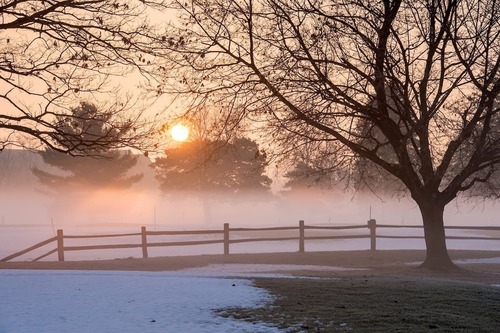
The changes currently underway at the Burke Golf Course on the southwest corner of the University of Notre Dame campus are just the latest for the nearly century-old greensward.
Holy Cross Drive, which forms the outer ring of Notre Dame’s interior campus, will be realigned over the next several months near The Burke and Duncan Hall into a broad sweeping curve to the west and south in order open up room within the ring for two new residence halls and additional recreational space, according to Doug Marsh, vice president for facilities design and operations and University architect.
“The Burke will be reconfigured but remain a 9-hole course,” Marsh said. “When completed late this summer, it will feature four par-3 and five par-4 holes. Construction progress this winter and spring followed by the summer growing season will all guide the greenskeepers in determining when the course is ready for play.”
The latest reconfiguration of The Burke is at least the fourth in its long history.
Golf was played sporadically at Notre Dame in the early 1900s with a rudimentary “course” built on the north side of St. Mary’s Lake. Students also played makeshift games in front of Badin and Bond Halls.
The sport was more formally introduced to Notre Dame in 1922 when some students from the southern United States introduced it to their peers. Within a year, a rapidly growing group of golf aficionados — known as the Snicker Sisters — began sponsoring tournaments and organizing a non-varsity team.
The rise in the popularity of the sport led to the opening in 1929 of a 6,500-yard, par-71 course. Funds came from a gift to the University from William J. Burke, founder and president of the Vulcan Last Corp. of Portsmouth, Ohio. Vulcan was involved in a wide variety of industries, including the Vulcan Golf Company. Sadly, Burke never played a round on the course. He died suddenly of a heart attack in July 1928.
“I don’t think things will change right away; it’s strictly a man’s deal here. Professors don’t want their wives out here, I know that. And the students have just never brought it up.”
The first realignment of The Burke came in the late 1930s in order to accommodate the construction of Rockne Memorial, the western capstone to the South Quad. Dedicated in 1939 in memory of Notre Dame’s legendary football coach Knute Rockne, The Rock is one of the most comprehensive recreational facilities on campus, providing space and equipment for students, faculty, staff, retirees and their families. A putting green is adjacent to The Rock.
A second reconfiguration took place over several years in the 1950s when Fisher and Pangborn Halls were constructed at the west end of the South Quad. Ironically, both halls will be razed in the next couple of years and replaced with new residences.
The biggest transformation of The Burke came in 1995, when the back 9 was eliminated in order to make way for four new residence halls — O’Neill Family, Keough, McGlinn and Welsh Family. Duncan and Baumer Halls were added later, making for a half-dozen on the West Quad. The course has played since the mid-’90s at about 3,220 yards and par 35.
For the first four decades of The Burke’s existence, it was a men’s-only course, though not without some controversy. Soon after the course opened in 1929, women at Saint Mary’s College asked to use the new recreational facility. The University Council took up the matter and turned down the request. Notre Dame’s president, Rev. Charles L. O’Donnell, C.S.C., wrote the following to his counterpart at Saint Mary’s, Sister Eleanore:
“I have to inform you reluctantly that your girls may not swing a niblick on our golf course, at least for the present. The reason for this decision seems to be, in a general way, the same reason which Rome (i.e., the Vatican) often gives — non expedit (not expedient). The real reason, which I do not mind giving you unofficially and confidentially, is that you have never allowed our boys to go boating on your lake.”
The SMC lake (not the St. Mary’s Lake on Notre Dame’s campus) was, according to University historian Rev. Arthur Hope, C.S.C., barely big enough to “slake the thirst of two frogs and four blue gills.”

The South Bend Tribune published a story on Aug. 1, 1969, in which local women lamented the men’s-only policy on the Notre Dame golf course. The course’s manager, Rev. George Holderith, C.S.C., said of a change: “We haven’t even discussed it,” adding, “I don’t think things will change right away; it’s strictly a man’s deal here. Professors don’t want their wives out here, I know that. And the students have just never brought it up.”
Whether it was the Tribune story, further requests from women golfers or the University’s early merger discussions with Saint Mary’s, the policy changed a year later and women began to “spoil a good walk” on The Burke in 1970.
At the time of the reduction to nine holes, South Bend Tribune sportswriter and golf columnist John Fineran wrote: “There is no guarantee, of course, that those nine holes will remain for golfers. Future university needs may gobble that land up.”
Now, almost 30 years later, he was prescient in part. While a portion of The Burke’s land is being taken for residential priorities, at least the course will survive, if in a truncated form.
Originally published by at ndworks.nd.edu on January 16, 2024.